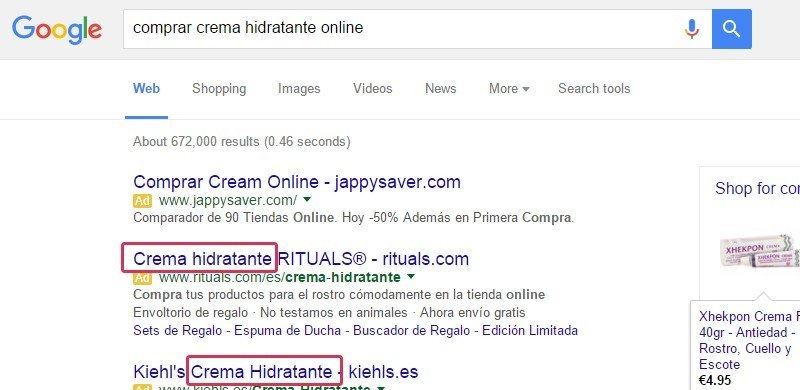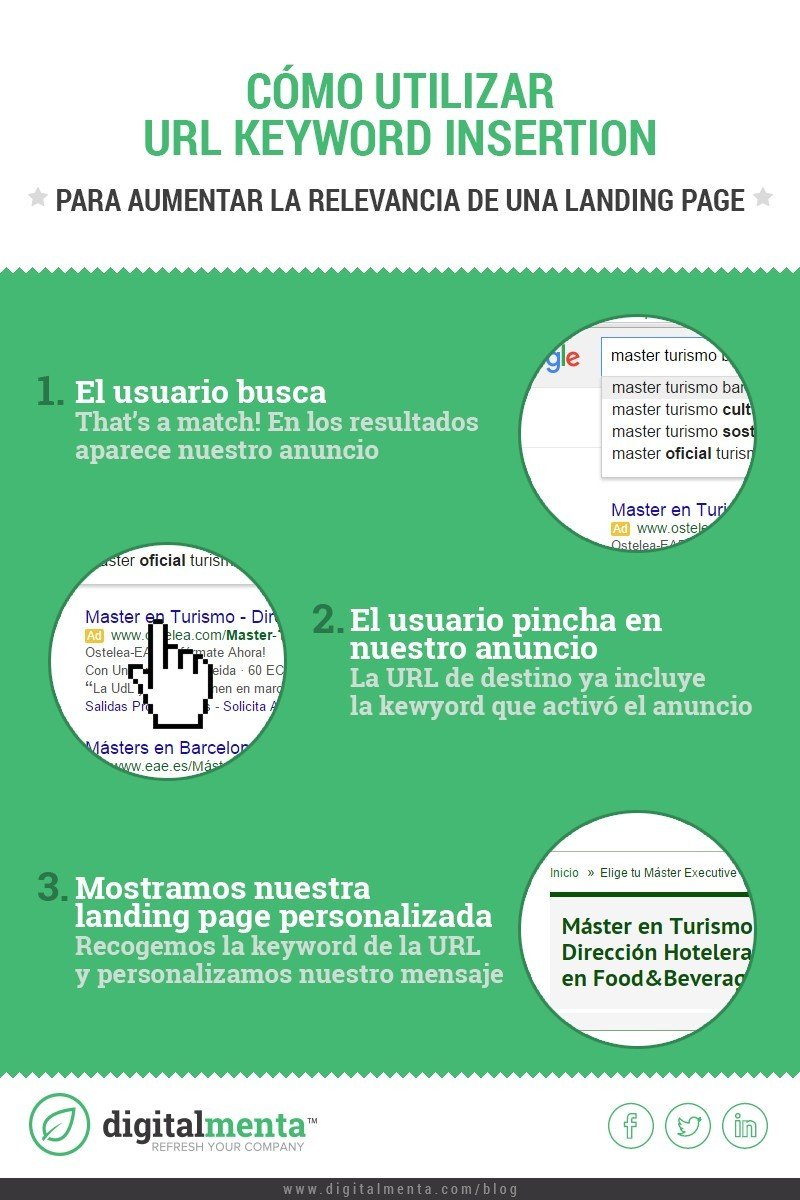Cómo utilizar Dynamic Keyword Insertion en URLs para aumentar la relevancia de una landing page
Si trabajas con campañas de AdWords sabrás que puedes mejorar mucho la eficiencia de tus anuncios mejorando la calidad y la relevancia de las Landing Pages.
Hay varios factores clave que determinan el quality score de una campaña. Entre ellos, la concordancia entre los headlines de tu anuncio y los contenidos de la landing page. ¿Coinciden? ¿Son coherentes? ¿Ofrecías “paracetamol” en el anuncio y, sin embargo, ofreces “medicinas” en tu landing page?
En este post vamos a explicar una sencilla técnica para aprovecharte de las keywords de las búsquedas y tus anuncios para maximizar las conversiones aumentando la relevancia de la landing page.
Antes de meternos en harina, estaría bien explicar el concepto de Dynamic Keyword Insertion, que está bastante relacionado con lo que vamos a hacer nosotros.
¿Qué es Dynamic Keyword Insertion?
Fundamentalmente, DKI es una funcionalidad que ofrece Google AdWords para poder personalizar el texto de los anuncios en función de la búsqueda del usuario.
Si la keyword de la búsqueda del usuario activa tu anuncio, puedes reemplazar una parte del anuncio con la keyword correspondiente de tu campaña para crear una coincidencia mucho más alta.

Screenshot de ejemplo de Dynamic Keyword Insertion
Por ejemplo, si vendes fruta online y tu anuncio se imprime con la búsqueda “comprar naranjas online”, tu podrías cambiar tu headline genérico “¡Compra fruta en 1 minuto!” por “¡Compra naranjas en 1 minuto!”.
Google te lo explica mejor aquí.
Cómo personalizar los contenidos de tu landing page en función de la keyword
A diferencia de la técnica de Dynamic Keyword Insertion para los anuncios, en la Landing Page no sólo podemos insertar la palabra clave sino que podemos modificar todo un headline o una imagen en función de lo que haya buscado el usuario. Podríamos personalizar todos los elementos clave de la landing page, que ya identificamos en este post.
Resumen de URL KEYWORD INSERTION para aumentar la relevancia de una Landing Page
Siguiendo con el ejemplo del ecommerce de fruta, si nuestro headline dice algo como “¿Quieres comprar fruta fresca en menos de 1 minuto?” y el usuario buscó “comprar naranjas online”, aumentaremos mucho la relevancia, la calidad y las probabilidades de conversión si le ofrecemos un headline como “¿Quieres comprar naranjas online en menos de 1 minuto?”.
Y podríamos personalizar el hero shot, el call to action… cuanto más personalizado sea el contenido de una Landing Page, mayor relevancia y más conversiones. Esto es así. Y punto.
Pero, ¿cómo se puede hacer?
Es muy sencillo pero lo puedes llevar a un alto nivel de complejidad. Nosotros os explicamos cómo hacerlo en PHP (por ejemplo) en 3 pasos:
1. Inserta la keyword en la URL de destino cuando configures tu anuncio.
Basta con añadir el snippet {keyword}, proporcionado por Google, en la URL. Por ejemplo:
https://landingpage.domain.net/?kw={keyword}
Esto nos devolverá la/s palabra/s clave que hayan activado el anuncio directamente en la URL.
2. Rescata la keyword de la URL
Creamos una variable a la que le asignamos el valor de la URL:
$keyword = $_GET[‘kw’];
3. Personaliza el contenido en función del valor de la variable keyword
Un sencillo condicional nos permitirá servir un contenido u otro en función del valor de la keyword. Por ejemplo:
if ((strpos($kw,’naranjas’) !== false)) { echo ‘¿Quieres comprar naranjas online en menos de 1 minuto?’;} else { echo ‘¿Quieres comprar fruta fresca en menos de 1 minuto?’;}
Beneficios de personalizar el contenido de una Landing Page en función de las keywords
-
- Personaliza una misma landing page para ofrecerle al usuario una mejor experiencia.
-
- Aumenta la relevancia de tu landing page.
- Aumenta el nivel de calidad (quality score) de tu campaña.
- Sube la posición media de tus anuncios.
-
- Aumenta tus conversiones!
Es un proceso relativamente sencillo que requiere una planificación y una estrategia adecuadas. pero sus beneficios pueden ser magníficos.




